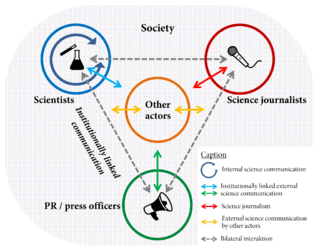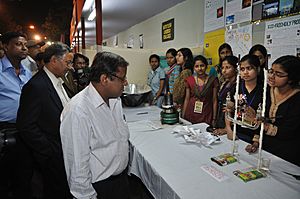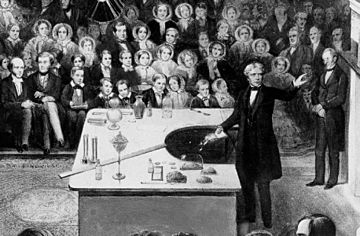Science communication facts for kids
Science communication is all about sharing science with others. It means telling people about science, teaching them, and making them excited about new discoveries. It also helps people understand why science is important.
People who share science are called science communicators. They can be scientists, writers, or even artists! The people listening can be anyone, from other scientists to students or the general public.
There are two main types of science communication:
- Outward-facing (also called science outreach): This is when scientists share their work with people who are not experts. Examples include science journalism (like science news articles) and science museums.
- Inward-facing (or "inreach"): This is when experts talk to other experts, even if they are from different science fields. Examples include sharing research in scientific journals.
Science communicators often use fun ways to share information. They might use entertainment, tell stories, or even use jokes and metaphors (comparing science ideas to everyday things). Some scientists even learn acting techniques to help them explain things better!
It's important to study how well science communication works. This helps make sure that sharing science is done in the best way possible.
Science communication can help people support scientific research and science education. It also helps people make good decisions, especially about government and right and wrong issues. When there's misinformation (wrong information) about science, good communication can help set things straight.
Today, scientists are asked more and more to share their findings with everyone, not just other scientists. This has led to new and creative ways to communicate science, like blogs, infographics, and even science comics or board games!
Contents
Sharing science is important for many reasons. In 1987, Geoffery Thomas and John Durant talked about why we need more people to understand science.
- For the country: More trained engineers and scientists can help a country's economy grow.
- For individuals: Science can be interesting and beautiful, like popular science books or science fiction movies. It also helps us understand the world around us, especially with all the new technology. For example, the science of happiness can help people live better lives.
- For society: When people understand science, they can make better choices for their communities and governments. This helps create a stronger democratic society. Science can also help us think about moral questions, like whether animals feel pain or how human actions affect the climate.
Sometimes, people used to think that only scientists truly understood science, and everyone else knew less. This idea is called the "deficit model." But now, we know that everyone has different knowledge, and science communication helps share what scientists know with others. It's about reducing the "knowledge gap" between people.
Some people worry that groups who don't like science can spread wrong information. For example, Randy Olson and Robert Krulwich have talked about how easily denialism (like denying climate change) can spread. It's important for scientists to tell their stories clearly and in an interesting way to help people understand the truth.
People like Carl Sagan and Neil deGrasse Tyson are famous for making science popular. They help many people get interested in science. However, it's important that popular science is accurate and not just exciting.
Marine biologist and filmmaker Randy Olson wrote a book called Don't Be Such a Scientist. He says that scientists need to learn how to communicate better. He believes scientists are the most important people to explain science to the public. Olson says they should use storytelling and be persuasive in their communication. He points out that people like Carl Sagan were good at this because they were also likable.
Journalist Robert Krulwich also encourages scientists to tell stories. He says scientists should use metaphors to make difficult ideas easier to understand, just like Galileo Galilei did. He also thinks sharing stories about scientists' own successes and struggles helps people see them as real people. Krulwich emphasizes that scientific ideas are based on hard-won knowledge, not just opinions.
Actor Alan Alda has even helped scientists learn to communicate better by using acting techniques.
Another way to share science is through "opinion leaders." These are people in communities, like teachers or business leaders, who can help share scientific information with others. Groups like the National Academy of Sciences use this approach.
Using What Works (Evidence-Based Practices)
Just like doctors use "evidence-based medicine" (methods proven to work), science communication can also use "evidence-based practices." This means using communication methods that research has shown to be effective.
It's important for people who study science communication and people who practice it to work together. This helps them learn from each other and find the best ways to share science.
Thinking About the Audience
When scientists share their work, they often think about who they are talking to. Richard Dawkins, a famous scientist, wrote his book The Selfish Gene for three types of readers: the general public, experts, and students.
Instead of thinking of just one "public," science communicators now think about many different "publics" or audiences. People are active and knowledgeable, and they can both receive and shape scientific ideas.
The goal of science communication is to help everyone feel like they can be part of science if they want to. It's not about forcing people to engage, but making it possible for them to join in.
Mental Shortcuts (Heuristics)
People make many decisions every day. To do this quickly, they often use "heuristics," which are mental shortcuts. These shortcuts help us make quick guesses. Here are a few examples:
- Representativeness: We guess how likely something is based on how much it seems to fit a certain idea. For example, if someone is very quiet and likes to read, you might guess they are a librarian.
- Availability: We guess how common or likely something is based on how easily we can think of examples. If you hear a lot about plane crashes, you might think they happen more often than they do.
- Anchoring and adjustment: We start with a first guess (an "anchor") and then adjust it. If you're asked to guess how many candies are in a jar, you might start with a number you saw in a similar jar before, and then adjust it up or down.
Good science communication understands these mental shortcuts. Simply giving people more facts often doesn't change their minds. It's important to present information in a way that works with how people naturally think.
Including Everyone (Inclusive Communication)
Science communication also needs to think about cultural differences. Different cultures might have different ideas about science or nature. A good way to share science should work for people from all backgrounds.
Inclusive science communication tries to reach groups of people who are often left out. This might involve using poetry, art, films, or games to help different communities learn about and discuss science.
The Public Understanding of Science Movement
The idea of "public understanding of science" became very important in the late 20th century. Before that, not many people focused on sharing science with the general public. However, some famous scientists like Michael Faraday gave public lectures, such as his famous Christmas Lectures, which started in 1825.
In the UK, a report called The Bodmer Report (published in 1985) changed how scientists shared their work. This report said that everyone should understand some science, and that science should be taught well from a young age. It also asked for more science news in newspapers and on television. This led to new ways for scientists to share their research with the public.
After World War 2, people's views of scientists changed. The Bodmer Report encouraged British scientists to share their research more widely. This led to the creation of groups like the Committee on the Public Understanding of Science (COPUS). These groups helped make sure that sharing science with the public was taken seriously.
In the European Union, governments started spending more money on science. So, they wanted research groups to share their findings with the public. Now, many research projects have a plan to communicate their work clearly to everyone.
Images for kids
-
This drawing by Thomas Edison from 1880 shows how a light bulb works.
-
Fredrich Koenig's steam-powered printing press from 1814.
See also
 In Spanish: Comunicación de la ciencia para niños
In Spanish: Comunicación de la ciencia para niños






